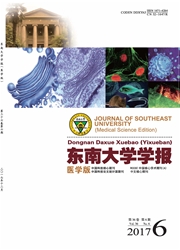

 中文摘要:
中文摘要:
目的:观察体外培养的大鼠肝细胞在促炎细胞因子IL-1β刺激下一氧化氮(NO)的产生和线粒体膜电位的变化,探讨两者之间的关系。方法:原位胶原酶灌注法分离和培养原代大鼠肝细胞后,分别用生理盐水、脂多糖(LPS)(10mg·L-1)、IL-1β(1nmol·L-1)及LPS(10mg·L-1)联合IL-1β(1nmol·L-1)刺激肝细胞,并分别在刺激后6、12、24、48h留取细胞和上清液,采用分光光度法测定上清液NO的含量,采用荧光探针Jc-1结合流式细胞仪检测肝细胞线粒体膜电位的变化。结果:IL-1β刺激后肝细胞产生NO增加而线粒体膜电位降低,两者均呈时间依赖性,并在24h达峰值;LPS对肝细胞NO的合成没有直接诱导作用,与IL-1β联合刺激也没有协同作用。结论:IL-1β诱导肝细胞过度产生NO从而抑制线粒体呼吸功能可能是炎症应激下肝损伤的潜在机制之一。
 英文摘要:
英文摘要:
Objective To observe the variation of nitric oxide (NO) production and mitochondrial membrane po- tential in cultured rat hepatocytes stimulated by IL-1β. The correlation between NO production and mitochondrial mem- brane potential alteration was investigated. Methods Primary cultured rat hepatocytes were isolated by an in situ colla- genase perfusion method. The cultured hepatocytes were stimulated by saline, LPS( 10 mg · L-1) ,IL-1β( 1 nmol · L-1) and LPS(10 mg· L-1) combined with IL-1β( 1 nmol · L-1) respectively. The culture medium and hepatocytes were collected at 6,12,24 and 48 hours after stimulation. The concentration of NO in the medium was detected by spectropho- tometry and the mitochondrial membrane potential of the hepatocytes was detected with flow cytometry after incubated with fluorescent probe JC-1. Results IL-1β promoted NO production and decreased mitochondrial membrane potential in cultured rat hepatocytes. Both effects were time-dependent and peaked at 24 hours. LPS did not induce NO produc- tion in rat hepatocytes and no synergistic effect was observed when co-stimulated by IL-1β stimulating simultaneously. Conclusion Excessive nitric oxide production induced by IL-1β results in an inhibition of mitochondrial function, which may be involved in the pathology of hepatic injury during inflammatory stress.
 同期刊论文项目
同期刊论文项目
 同项目期刊论文
同项目期刊论文
 Glutamine Reduces TNF-α by Enhancing Glutathione Synthesis in Lipopolysaccharide-stimulated Alveolar
Glutamine Reduces TNF-α by Enhancing Glutathione Synthesis in Lipopolysaccharide-stimulated Alveolar Glutamine attenuates lipopoly saccharide-induced acute lung injury through enhancing glutathione syn
Glutamine attenuates lipopoly saccharide-induced acute lung injury through enhancing glutathione syn 期刊信息
期刊信息
